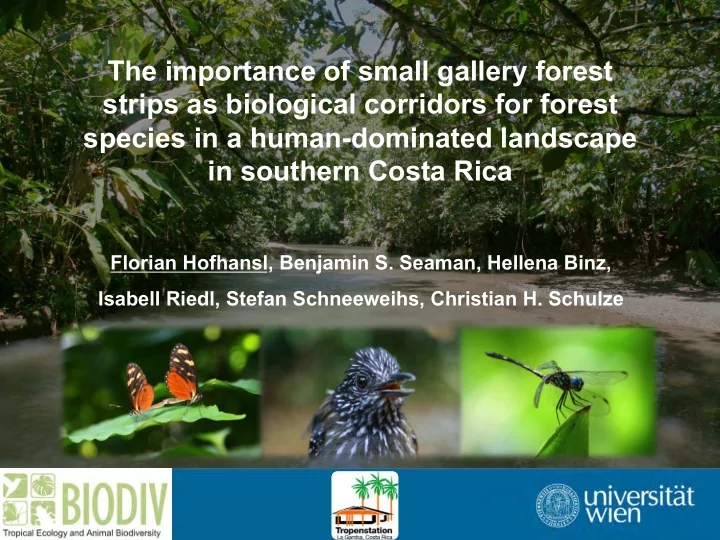

The importance of small gallery forest strips as biological corridors for forest species in a human-dominated landscape in southern Costa Rica Florian Hofhansl, Benjamin S. Seaman, Hellena Binz, Isabell Riedl, Stefan Schneeweihs, Christian H. Schulze
Gallery Forest • Costa Rican forestry law protects forest strips of 30-100 m width along every stream and river. • Network of linear forest strips that cross the agricultural matrix of open land. • Some strips are connected to closed forest, while others are entirely isolated.
Gallery Forest
Gallery Forest
Gallery Forest
Habitats • Forest (F): large patches of closed primary or secondary forest. • Connected gallery forest (GC): directly connected to closed forest. • Isolated gallery forest (GI): without canopy connection to closed forest; 300–600 m distance from forest.
Questions • Difference in richness and composition of forest species between habitat types? à Conservation relevance of gallery forest? • Difference between connected and isolated gallery forests? à Importance of connectivity? • Correlation of species richness ( α -diversity ) and species composition ( β -diversity ) of different species groups. à Which measure is better suited for comparing species’ response to habitat change?
Study Sites Forest Connected GF Isolated GF Birds Butterflies Dragonflies Underst. Birds
Sampling Methods Birds (103 forest species; 71.53 % of total): • 33 sites (11 F, 11 GC, 11 GI) • 10 min point counts, 25 m radius • visual and acoustic identification • 10-12 times per site Dragonflies (18 forest species; 34.62 % of total): • 19 sites (5 F, 7 GC, 7 GI) • sweep-netting for 1 hour within 50 metres of shoreline • 3-4 times per site
Sampling Methods Butterflies (53 forest species; 70.67 % of total): • 30 sites (10 F, 10 GC, 10 GI) • sweep-netting and visual identification along 50 m transects • 15 min per transect • 6 times per site Understory Birds (73 forest species; 81.11 % of total): • 12 sites (4 F, 4 GC, 4 GI) • mist-netting with 4 mist-nets per site (12 x 2.5 m, 16 mm mesh) • 3-4 days of mist-netting per site, ca 7 hours per day
Species Richness Number of species 100 F 40 90 GC GI 35 80 Birds & Understorey birds Butterflies & Dragonflies 70 30 60 25 50 20 40 15 30 F 10 20 GC 5 GI 10 Chao 2 esti 0 0 recorded Birds Understorey Birds Butterflies Dragonflies
Species Richness GC 100 % F equivalent GI 100 % F equivalent GI 100 % GC equivalent Birds Understorey Butterflies Dragonflies Chao 2 estimates Birds
Alpha Diversity Spearman rank correlation (of recorded number of species per site): Understorey Birds Butterflies Dragonflies Birds Birds R = -0.02, Understorey N = 12, Birds p = 0.953 R = -0.1, R = -0.04, N = 30, N = 12, Butterflies p = 0.584 p = 0.909 R = 0.17, R = 0.28, R = 0.27, N = 17, N = 6, N = 17, Dragonflies p = 0.512 p = 0.536 p = 0.275 à N = refers to number of sites where both taxa were found à No significant effects - No correlation between taxa! à α -diversity no indicator of changes over habitat types across taxa!
Species Composition Birds Butterflies Dimension 2 * F ≠ GC ≠ GI Stress: 0.19 Stress: 0.14 * F ≠ GC & GI Dragonflies Understorey Birds F GC GI * F ≠ GC ≠ GI Stress: 0.08 * F ≠ GI Stress: 0.22 Dimension 1
Beta Diversity Spearman matrix rank correlation (of Bray-Curtis matrices) : Understorey Birds Butterflies Dragonflies Birds Birds Rho = 0.726, Understorey N = 12, Birds p = 0.001 Rho = 0.661, Rho = 0.452, N = 30, N = 12, Butterflies p = 0.001 p = 0.008 Rho = 0.062, Rho = 0.684, Rho = 0.083, N = 17, N = 6, N = 17, Dragonflies p = 0.302 p = 0.003 p = 0.245 à Based on randomization – significant pattern is NOT incidental! à Changes in composition are similar between taxa à β -diversity as indicator of changes over habitat types across taxa
Conclusions • Species richness: – Highest in forest but substantial number of forest species occur in gallery forests as well. – Conservation value of gallery forests: connected >>> isolated • Species composition: – Forest interior set apart from gallery forests for birds and butterflies but not dragonflies – Distinct species assemblages of understorey birds at connected and isolated gallery forest sites.
Conclusions • No congruency of species richness between taxa. • But: similar changes of species composition . à β -diversity represents better measure for comparing changes over habitat types between species groups than α -diversity . • Conservation implication: (1) gallery forests are important habitat patches for forest species in human-dominated landscapes (2) increase landscape permeability for forest species (3) act as biological corridors for additional forest species (?)
Acknowledgements Ministerio de Costa Rica: MINAE (Ministerio Nacional de Ambiente y Energia) Tropical Research Station La Gamba: Anton Weissenhofer, Werner Huber Victor Cruz-Garcia, Luis Sanchez-Jimenez, Eduardo Arauz-Suarez www.univie.ac.at/bdef
Tropical Research Station La Gamba http://www.lagamba.at
Recommend
More recommend